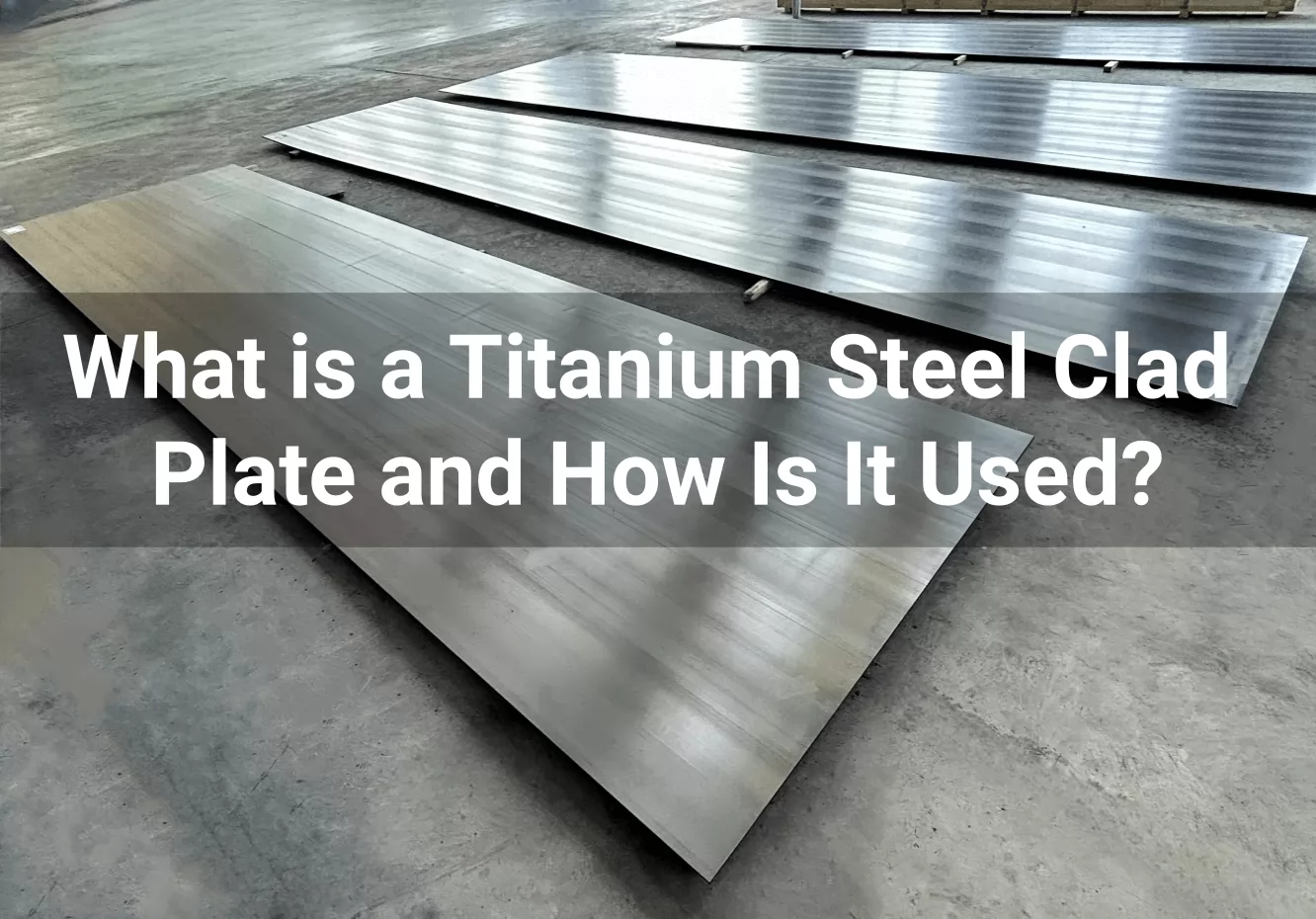


Titanium steel clad plates are advanced composite materials that represent a perfect blend of innovation, durability, and functionality. These plates combine the remarkable corrosion resistance and lightweight properties of titanium with the superior strength, structural integrity, and cost-efficiency of steel.Crafted through sophisticated techniques such as explosive bonding, hot rolling, or cold rolling, titanium steel clad plates exhibit exceptional performance characteristics tailored for use in demanding industrial environments.
By offering a synergy of high performance and affordability, these versatile materials have become indispensable in industries ranging from chemical processing and marine engineering to energy production and aerospace applications.
Titanium steel clad plates are advanced composite materials that combine the exceptional properties of titanium with the structural strength and cost-effectiveness of steel. These plates are typically produced through deformation and bonding processes such as hot or cold rolled bonding, or explosive bonding, which effectively fuse titanium to steel. This results in a material that retains the low cost and high strength of steel while offering the superior corrosion resistance of titanium.
Corrosion Resistance:
Titanium steel clad plates exhibit outstanding corrosion resistance, particularly in harsh environments. The titanium layer offers exceptional resistance to chlorides, sulfides, ammonia, and seawater, making it a superior choice over stainless steel, copper alloys, or even pure titanium in many conditions. This corrosion resistance is especially critical in industries like marine engineering, chemical processing, and offshore applications.
Heat Resistance:
Titanium steel clad plates also excel in heat resistance, maintaining their strength and resisting oxidation at high temperatures, up to 1,000°F. This makes them ideal for applications in power plants, heat exchangers, and other high-temperature environments where materials are subjected to extreme heat.
Mechanical and Welding Properties:
Titanium steel clad plates possess high mechanical strength and excellent stamping properties. They can be easily welded, with joints retaining up to 90% of the base metal’s strength. The material also boasts good machinability, making it suitable for various manufacturing processes and applications.
Cost-Effectiveness:
While pure titanium is known for its excellent properties, it is also costly. Titanium steel clad plates offer a more affordable solution by using a titanium layer bonded to a steel base. This reduces the overall cost while still providing the high performance of titanium, making it an ideal material for applications that demand both performance and budget considerations.
Titanium steel clad plates are an essential material across various industries due to their unique combination of high strength, corrosion resistance, and cost-effectiveness. By bonding titanium, which offers exceptional corrosion resistance, to steel, which provides strength and durability, these composite plates offer an ideal solution for environments where performance and reliability are crucial. The following are key applications where titanium steel clad plates are making a significant impact:
Titanium steel clad plates combine the strength and durability of steel with the corrosion resistance and lightness of titanium. These composite materials are produced using sophisticated bonding and rolling techniques to achieve the desired mechanical and performance properties. Below is a detailed explanation of the processes involved in producing titanium steel clad plates, including explosive bonding, hot rolling, and cold rolling.
Explosive bonding, also known as explosive cladding, is a high-energy process used to bond two or more metals through a controlled explosive detonation. This method is commonly employed to bond titanium to steel, resulting in a composite plate that combines the superior properties of both metals. The process begins with the preparation of materials, where the base material, typically steel, is cleaned and prepared for bonding. The titanium cladding material is also cleaned to remove contaminants like oil, dirt, or rust. The titanium sheet is then placed on top of the steel plate, with a specific gap between the two.
Next, a layer of explosive material is placed above the titanium sheet. The explosive is carefully calculated to ensure the right amount of pressure and heat is generated for bonding. Once the detonation occurs, a shockwave is created that forces the titanium onto the steel at extremely high velocity. This shockwave causes both metals to deform, interpenetrate, and bond at the molecular level, forming a metallurgical bond without the need for welding. After detonation, the newly bonded titanium-steel plate is slowly cooled to prevent stress cracking and to stabilize the bond. Finally, the plate undergoes inspection to check the bond quality, thickness, surface finish, and overall integrity.
The advantages of explosive bonding include the creation of a strong, durable bond that is resistant to mechanical separation. This process combines the strength and cost-effectiveness of steel with the corrosion resistance and lightweight properties of titanium. Additionally, explosive bonding is versatile, capable of bonding dissimilar metals that would typically be difficult to join using traditional methods.
Hot rolling is a process in which a titanium-steel clad plate is heated above its recrystallization temperature and then passed through rollers to reduce its thickness and achieve the desired dimensions. This technique ensures excellent bonding between the titanium and steel. The process begins by heating the explosive-bonded titanium-steel composite plate to a temperature between 850°C and 1100°C, depending on the specific metals involved. Once heated, the composite plate is passed through a series of rollers that reduce its thickness and create a uniform, consistent plate. The high temperature and pressure applied during hot rolling improve the bond strength between the titanium and steel by allowing the materials to deform and merge under pressure.
After rolling, the plate is allowed to cool slowly to maintain its mechanical properties and prevent thermal stresses. In some cases, surface treatments such as pickling are applied to remove any surface oxides and improve the surface finish. The advantages of hot rolling include an enhanced metallurgical bond between the titanium and steel, facilitated by the high temperature and pressure. This process also enables the production of large composite plates with uniform properties and dimensions, making it ideal for industrial applications. Additionally, hot rolling refines the microstructure of the metals, resulting in enhanced strength and improved mechanical performance of the composite plate.
Cold rolling is a process in which the thickness of a titanium-steel clad plate is reduced at room temperature. This method is particularly well-suited for producing thinner plates with high precision and a smooth surface finish. The process begins with the cleaning and inspection of the hot-rolled titanium-steel clad plate to ensure it is free from defects before it undergoes cold rolling. The plate is then fed through a series of rollers at room temperature, which compress and reduce its thickness. Cold rolling not only provides precise control over the thickness and dimensions of the plate but also enhances its surface finish, making it smoother and more uniform.
In some cases, after cold rolling, the composite plate may be annealed in a furnace to relieve internal stresses and improve the material's ductility and formability. Once the cold rolling is complete, the plate undergoes final inspection to check for defects, bond integrity, and dimensional accuracy. Surface treatments, such as pickling or polishing, may also be applied to achieve a clean, oxide-free finish. The advantages of cold rolling include high precision, making it ideal for applications that require tight tolerances. Additionally, the process results in a superior surface finish, which is crucial for applications where aesthetics or corrosion resistance are important. Cold rolling also enhances the mechanical properties of the titanium-steel clad plate, increasing its yield strength and hardness.
Titanium clad steel plates offer a unique combination of strength, corrosion resistance, and affordability. This makes them an ideal replacement for pure titanium in many applications. Additionally, the expanding applications of titanium steel clads in industries such as marine, oil and gas, aerospace, and chemical processing highlight their growing importance.
Titanium clad steel plates are manufactured to meet stringent standards like ASTM B898, with various grades available for cladding (e.g., Gr. 1, Gr. 2, Gr. 7) and base metals (e.g., ASTM A516, A387, A240). They are customizable in terms of size, thickness, and technique, including blast bonding and rolling.
Enhanced Durability: Titanium’s resistance to water impact and corrosion outperforms conventional metals like steel and aluminum.
Environmental Resistance: Ideal for harsh environments, including marine, chemical, and high-temperature conditions.
Lightweight Design: Titanium’s low density reduces weight, making it ideal for aerospace, marine, and automotive applications where structural weight is critical.
Titanium steel clad plates bridge the gap between cost and performance, offering superior properties for industries requiring corrosion resistance, high strength, and durability. Whether for marine engineering, chemical processing, or aerospace, these composite plates are a modern engineering marvel.
For high-quality titanium steel clad plates or customized solutions, consider FUGO Tech, a trusted manufacturer specializing in titanium composite materials. With expertise in design and production, FUGO Tech serves clients worldwide, including markets in India, North America, Europe, and the Middle East. Contact FUGO Tech today for competitive pricing and reliable quality!
Read More:
Comparison of Mechanical Properties for Titanium-Steel Clad Plates - FUGO Tech
Nickel Clad Plate & Titanium Clad Plate in Flue Gas Desulfurization Systems - FUGO Tech
Applications of Zirconium-Steel Clad Plate - FUGO Tech
[Material info] Applications of Titanium Clad Plates - FUGO Tech
Elements of Butt Welding of Titanium Steel Clad Plates - FUGO Tech
What is a Titanium Steel Clad Plate and How Is It Used? - FUGO Tech



Fugo Tech is focused on the manufacturing of clad metal plate and distributes the Stainless Steel, Titanium, Nickel Alloy, Zirconium and other non-ferrous metal pipes, fittings, flanges, and fasteners.